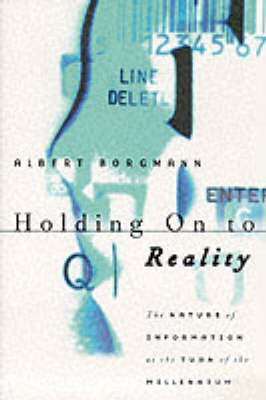
Holding On to Reality
The Nature of Information at the Turn of the Millennium
Seiten
2000
University of Chicago Press (Verlag)
978-0-226-06623-3 (ISBN)
University of Chicago Press (Verlag)
978-0-226-06623-3 (ISBN)
A history of information from its inception in the world to its transformation of culture. Drawing on the history of ideas, details of information technology, and boundaries of the human condition, this text explains the relationship between things and signs, and between reality and information.
In the late-1990s people hear constantly about the "information revolution". The 24-hour news channels and dizzying Internet technologies bombard people with facts and pictures from around the globe. But what kind of a "revolution" is this? How has information really changed from what it was ten years or ten centuries ago? This work offers some answers to these questions. Albert Borgmann has written a history of information, from its inception in the natural world to its role in the transformation of culture - in writing and printing, in music and architecture - to the late-1990s Internet mania and its attendant assets and liabilities. Drawing on the history of ideas, the details of information technology, and the boundaries of the human condition, Borgmann explains the relationship between things and signs, between reality and information. His history ranges from Plato to Boeing and from the alphabet to virtual reality, all the while being conscious of the enthusiasm, apprehension, and uncertainty that have greeted every stage of the development of information.
The book is underscored by the humanist's fundamental belief in human excellence and by the conviction that excellence is jeopardized unless we achieve a balance of information and "the things and practices that have served us well and we continue to depend on for our material and spiritual well-being - the grandeur of nature, the splendour of cities, competence of work, fidelity to loved ones, and devotion to art or religion".
In the late-1990s people hear constantly about the "information revolution". The 24-hour news channels and dizzying Internet technologies bombard people with facts and pictures from around the globe. But what kind of a "revolution" is this? How has information really changed from what it was ten years or ten centuries ago? This work offers some answers to these questions. Albert Borgmann has written a history of information, from its inception in the natural world to its role in the transformation of culture - in writing and printing, in music and architecture - to the late-1990s Internet mania and its attendant assets and liabilities. Drawing on the history of ideas, the details of information technology, and the boundaries of the human condition, Borgmann explains the relationship between things and signs, between reality and information. His history ranges from Plato to Boeing and from the alphabet to virtual reality, all the while being conscious of the enthusiasm, apprehension, and uncertainty that have greeted every stage of the development of information.
The book is underscored by the humanist's fundamental belief in human excellence and by the conviction that excellence is jeopardized unless we achieve a balance of information and "the things and practices that have served us well and we continue to depend on for our material and spiritual well-being - the grandeur of nature, the splendour of cities, competence of work, fidelity to loved ones, and devotion to art or religion".
Albert Borgmann is the Regents Professor of Philosophy at the University of Montana. His books include Technology and the Character of Contemporary Life and Crossing the Postmodern Divide, both published by the University of Chicago Press.
| Erscheint lt. Verlag | 5.1.2001 |
|---|---|
| Sprache | englisch |
| Maße | 17 x 23 mm |
| Gewicht | 425 g |
| Themenwelt | Geschichte ► Teilgebiete der Geschichte ► Technikgeschichte |
| Mathematik / Informatik ► Informatik | |
| Sozialwissenschaften ► Kommunikation / Medien ► Kommunikationswissenschaft | |
| ISBN-10 | 0-226-06623-1 / 0226066231 |
| ISBN-13 | 978-0-226-06623-3 / 9780226066233 |
| Zustand | Neuware |
| Haben Sie eine Frage zum Produkt? |
Mehr entdecken
aus dem Bereich
aus dem Bereich
Buch | Softcover (2024)
Lehmanns Media (Verlag)
CHF 27,90
Digitalisierung neu denken für eine gerechte Gesellschaft
Buch | Hardcover (2023)
Quadriga (Verlag)
CHF 27,95
Vom Perceptron zum Deep Learning
Buch | Softcover (2022)
Springer Vieweg (Verlag)
CHF 27,95


